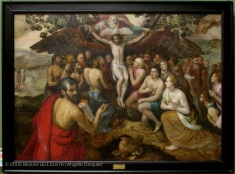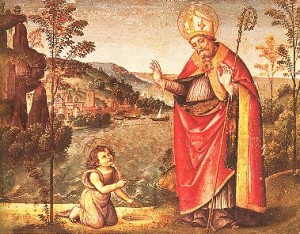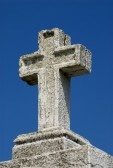“Go, therefore, make disciples of all the nations; baptise them in the name of the Father and of the Son and of the Holy Spirit…” [Matthew 28:19]
[1] Allegory of the Trinity, by Frans Floris, 1562 [2] An image of St Augustine and child on the beach. [3] A large stone cross from Northern Spain.
June 3 was Trinity Sunday, the second Sunday morning since we arrived at De La Salle University-Manila. Again, we went to the nine o’clock Mass at The Pearl of Great Price Chapel on campus. The preacher this time was an Indonesian priest.
He wanted to do practical reflections on the Trinity, he said, because our minds, as St Augustine discovered in the 5th century, cannot comprehend the Holy Trinity. He was, of course, referring to a popular story that circulated Europe during the Middle Ages:
- One day St Augustine, while thinking about the Trinity, saw a little boy on the beach. This boy was trying to put all of the ocean’s water into a tiny hole he had dug in the sand. He ran back and forth carrying water from the ocean to pour into the hole. Saint Augustine went up to the boy and asked what he was doing. The boy explained that he was emptying the entire ocean into the hole. Saint Augustine then attempted to explain the impossibility of the boy’s task. The boy, however, countered by telling Saint Augustine that he would sooner empty the entire ocean into the hole than Saint Augustine would ever fully grasp the whole mystery of the Trinity. To make a long story short, the boy who schooled Saint Augustine turned out to be an angel and Saint Augustine learned his lesson.
In theology, students may begin with a course on creation. But “creation” is a theological understanding, not a scientific comprehension. Creation as a subject proceeds from and subsists in a language of faith. It is the language used by the people of faith who want to understand, beyond the scientific data, how things come to be as they are today. It is, as the early Hebrews of more than three and a half millennia ago did, to certify the present when they wrote the narratives which we now collect as the first book of the Bible, the Book of Genesis. For people of faith, then, to accept that the world was created, is at the same time to proclaim that God is the Creator. The Hebrews first asserted it in their Scripture, and the Christian church just accepted it as received faith and has ever since been articulating it in the works of the early Church Fathers, in their creeds and in their theological enterprise down through the last two millennia. Just as creation was not a truth-claim generated in a theology library, so too the question “Who is this God of whom we confess that he is the Creator?” is an identity-question that cannot be answered without recourse to the interlocking narratives. To get an insight into the “Who” of this Creator-God, as Christians, we will always need to turn, firstly, to the story familiar to the Hebrew people, that speaks of their being the chosen and the elect of God, and to sense their struggle for comprehension in the midst of incomprehensible chaos where they were enslaved, invaded, and banished into exile. Only then, would we comprehend why they turned as they did to God, in order to provide, by way of story-telling, an identity description of this God who is the Creator of heaven and earth, who had chosen them, who somehow allowed all this chaos to happen, but who alone would put things right and re-create the nation of Israel. And then, as Christians, we will always have to tell not only the story of God’s relationship with Israel, but of God’s presence in Jesus Christ and the church and the world in the Spirit.
In other words, talking about the Creator involves at the same time the task of relating all this talk to our understanding of how God is reconciling the world, and about the hope that we have in God bringing about the perfection of his relationship with creation. The context of Christian dialogue on this subject is the way in which we believe that we experience the present reality, and the way we hope for the future consummation of what is promised in Scripture. This living experience and hope is closely related to the witness of Scripture and forms a constitutive aspect of the way questions about God and Creator are dealt with in Christian theology. Within this context, the Christian answer to the question “Who is this God of whom we confess that he is the Creator?” is: the Father and the Son and the Holy Spirit.
To invoke the threefold divine name is the only appropriate way that Christians in their experience from the early disciples down through the ages have discovered in response to the identity of the God of Israel in Jesus Christ through the Holy Spirit. The doctrine of the Trinity has come to provide the framework that regulates the who-question and the what-question in Christian theology, and guides the way we interpret the Bible and express our findings, the way we carry out conceptual reflection, and the way we experience our relationship in community.
On June 3, the preacher at the Chapel of the Pearl of Great Price rightly decided that a theological analysis of the Holy Trinity from the pulpit was not going to be of much use and we silently applauded his practical good sense. Instead, he opted to speak on some practical implications inspired by the Trinity. This was a very sensible move, to ensure that the congregation would have something to take home with them after the liturgy of the Word. He chose three things which were refreshingly simple but practical, which we here reproduce and use as basis for further reflection.
First, each time we sign the Cross, we affirm the glory of the Father, the suffering of the Son, and the love of the Holy Spirit.
- Meditating on this Trinitarian sign is a practical-spiritual way of remembering the Triune God in our hearts and inviting God to stay with us throughout our twenty-four hour day of thoughts, words and actions.
Second, the Cross is also a “plus” [“+”] sign. As a plus sign, it is full of positive energy and positive power. The preacher was talking very positively, implied in which is what we would call in theology a positive or optimistic anthropology: there is a lot that each one of us can do for kingdom-advancement, despite our post-Adam “fallen” [better read as “wounded”] nature, and regardless of our station in life.
It is easy, the Indonesian preacher observed, to fold one’s arms, to refuse to get involved, to do nothing. Arms folded indicate a standoffish mentality. More importantly in the drift of the preacher’s train of thoughts, it means there is “no cross-sign”. One needs to open one’s arms wide before the body can form a cross-sign. But it takes energy to open up, to stretch out one’s hands, for much-needed work of outreach everywhere we turn.
This message is outrageously simple, and yet profoundly practical. Strangely, his simple message sounded particularly poignant that morning in the light of a statue of Jesus Christ right beside him. It so happened that as he preached from the pulpit in that chapel, the wooden statue of Jesus Christ fixed on the wall, to his left and right behind the altar, portrays a triumphant Christ with his right arm pointed upwards, indicating resurrection-victory and his vertical attachment to the Father, and his left arm horizontally outstretched, indicating his suffering on the cross as a consequence of his horizontal outreach towards the wounded humanity.
- In line with the best of traditional Catholic theology, we espouse an optimistic anthropology – “Yes, we can.” But, the point is, if we can, we must! This is responsible discipleship. And this is the positive aspect of Pelagius’ rigorist moral teaching for a corrupt society in general and a corrupt clergy of his time in particular, his being branded a heretic in the controversial and antagonistic atmosphere of his era notwithstanding. Pelagius was a committed, faithful, minister working hard on kingdom-advancement. How could someone like him possibly be accused of neglecting God and insisting on the human person as the exclusive foundation of all things, and be excommunicated for heresy? Only a narrow focus on some favourite doctrinal articulation, coupled with an unforgiving and unaccommodating spirit and a readiness to use the power that came with certain office, did one wield power to completely exclude and atrociously punish another who thought and doctrinally-articulated differently. All the gospel-compliant life witness in the other person seemingly mattered little, if at all. Plainly, there was a colossal failure to recognise the possibility of particles of truth in what the other person has to say. Throughout church history, authoritarianism and the deification of dogma have tramped out intellectual power and pastoral sensitivity.
- Are things any different today? Are office-bearers in privileged ecclesiastical positions of power not once again showing no hesitation to use their so-called “power” to excommunicate on narrow doctrinal, debatable issues, those most committed and most hard-working ministers on the ground? In recent memory, these latter include the liberation theologians of Latin America who live out God’s option for the poor amongst the oppressed. Today, they particularly include the North American Catholic Nuns who serve the poor and marginalized, run schools and health care. These nuns are the very hands and feet of Jesus in contemporary American society. And yet, on some alleged doctrinal grounds, they epitomize the objects of Roman contempt. Whenever one studies closely the actual handling of all these disputes – from Yves Congar to Luis Dupuis and Elizabth Johnson; from Leonardo Boff to the LCWR – the reigning mentality that drives the modus operandi of the officials, and therefore the real and decisive official criterion at the end of the day, is ultimately not truth, but “Who is the boss?”
- For the rest of the Catholic world that watches all this in horror and suppressed indignation against a clerical mentality singularly reflected in the unapologetic announcement “We are the ones to decide!”, what can they do? What positive energy can they summon and put to good use? They could pray for the day when the People of God would spontaneously gather and galvanise from the ground up into a Catholic Tahrir Square, openly expressing their opinions, demanding to be heard this time, and “evicting” the tyrants, at least in the reality of their spiritual existence.
- The positions of the officials being, to use a Chinese expression, as solid as “an iron race bowl”, making an actual eviction of recalcitrant officials is mere fairy-tale talk. The first step that all responsible people can, and therefore must, do is to say to themselves and then to their friends: “This action/decision by the officials of the official church is not acceptable to the larger Church, the People of God.”
Third, going straight is easy, the preacher announced, for “one does not have to do anything.” But, at the crossroads, one has to look at the front, left and right, as well as behind. One needs power and energy to do it right. That’s what it means to be a Christian; it demands something of us.
- “Keep watch and pray that you will not fall into temptation,” [Mark 14::38] Jesus exhorts his disciples as he prays and agonizes, and even sweats blood according to Luke, in the Garden of Gethsemane. “Watch” and “pray” are the two key words. To keep watch requires much work. We need to stay awake and be aware of what’s going on around us. This is staying alert and maintaining sensitivity in our horizontal dimension of social activities. Praying takes up the vertical dimension. This is the element of vertical attachment to God. All told, much conscious work is called for to be both watchful and prayerful. In the end, hopefully, as men and women of faith, we may all find a place in a Church the Lord Jesus has left behind. This Church must struggle and learn to be inclusive as Jesus was inclusive, so that all her members may, together with Peter, say to the Lord: “Lord, to whom shall we go? You have the message of eternal life” [John 6:68].
Copyright © Dr. Jeffrey & Angie Goh, August 2012. All rights reserved.
You are most welcome to respond to this post. Email your comments to us at jeffangiegoh@gmail.com. You can also be dialogue partners in this Ephphatha Coffee-Corner Ministry by sending us questions for discussion.



